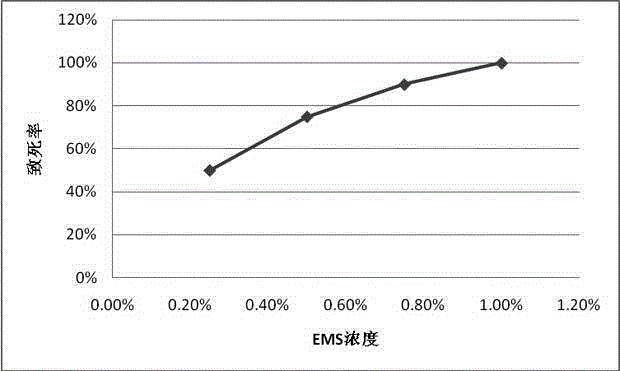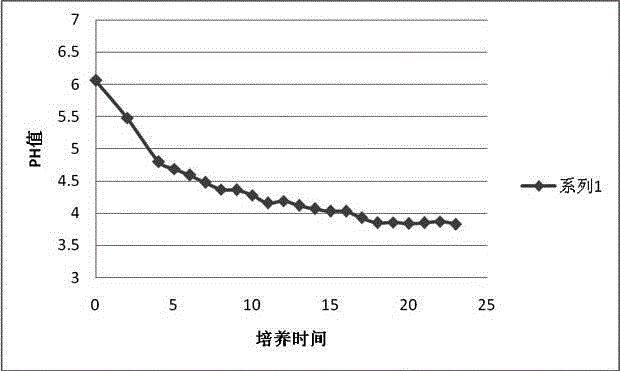Screening method and application of lactobacillus plantarum
A technology of Lactobacillus plantarum and Lactobacillus, applied in application, microorganism-based methods, microorganisms, etc., can solve problems such as adverse effects, reduced nutritional value, infection of spoilage bacteria, etc., and achieve the effect of good thermal stability
- Summary
- Abstract
- Description
- Claims
- Application Information
AI Technical Summary
Problems solved by technology
Method used
Image
Examples
Embodiment 1
[0019] Embodiment 1: the acquisition of Lactobacillus plantarum.
[0020] One: the acquisition of wild Lactobacillus plantarum.
[0021] Source of bacteria: isolated from homemade yogurt. Under aseptic conditions, take 5 mL of yogurt, add it to 45 mL of sterile distilled water, shake fully for 5 minutes, and serially dilute by 10 times, starting from 10 -1 ~ 10 -7 Gradient, choose the appropriate gradient, take 100uL and apply it on the 3 MRS (peptone 10g, yeast extract 5g, beef extract 10g, glucose 20g, dipotassium hydrogen phosphate 2g, ammonium citrate 2g, sodium acetate 5g, magnesium sulfate 0.58g, manganese sulfate 0.25g, Tween 80 1mL, agar 15g, Distilled water 1L, pH6.50) culture medium, 30 ℃ static culture and count. Select a single colony with obvious calcium dissolution circle, carry out Gram staining test, and microscopic examination. Gram-positive bacteria were selected for streak isolation and purification for 2 to 3 times, and the isolated and purified sing...
Embodiment 2
[0063] Example 2, identification of antibacterial effect of Lactobacillus plantarum) CGMCC No 5297.
[0064] From Example 1, it can be seen that plant lactobacillus (CLactobacillus plantarum) CGMCC No 5297 of the present invention has a strong inhibitory effect on Listeria monocytogenes, so it is speculated that this bacterial strain can secrete bacteriocin, and the plant lactobacillus (CLactobacillus plantarum) can be treated by the following method The antibacterial effect of CGMCC No 5297 and its secreted bacteriocin were identified.
[0065] 1. Eliminate factor interference.
[0066] 1. Eliminate acid interference.
[0067] The test method for inhibiting pathogenic bacteria is the Oxford cup double-layer plate method: LB culture medium for indicator bacteria containing 1.5% agar: 10 g of egg white, 5 g of yeast extract, 10 g of sodium chloride, 1.0 L of steamed water, pH7. 0. Pour 10mL per plate into a sterile Petri dish and cool it in a clean bench. Gently place the ...
Embodiment 3
[0094] Example 3 Inhibition of Lactobacillus plantarum CGMCC No 5297 on Listeria monocytogenes.
[0095] 1. Effect of bacteriocin produced by Lactobacillus plantarum CGMCC No 5297 on the growth curve of Listeria monocytogenes.
[0096] Use an inoculation loop to pick a single colony of Listeria monocytogenes CVCC1595 in 5ml LB medium, and culture overnight at 37°C. Inoculate in fresh LB medium according to 1% inoculum amount, and culture at 37°C until plateau stage. Dilute with fresh LB to about 10 bacteria 6 cfu. Then each test tube was divided into 2.75ml and divided into 4 groups. Group 1 added 250ul MRS medium as the control. Group 2 added 250ul CGMCC5297 sterile supernatant, Group 3 added 125ul CGMCC5297 sterile supernatant + 125ul MRS medium, Group 4 added 62.5ul CGMCC5297 sterile supernatant + 187.5ul MRS medium. The pH of the sterile supernatant of the above CGMCC5297 was adjusted to 6.0. Put 4 groups of test tubes together at 30°C for static culture, take one tu...
PUM
 Login to View More
Login to View More Abstract
Description
Claims
Application Information
 Login to View More
Login to View More - R&D
- Intellectual Property
- Life Sciences
- Materials
- Tech Scout
- Unparalleled Data Quality
- Higher Quality Content
- 60% Fewer Hallucinations
Browse by: Latest US Patents, China's latest patents, Technical Efficacy Thesaurus, Application Domain, Technology Topic, Popular Technical Reports.
© 2025 PatSnap. All rights reserved.Legal|Privacy policy|Modern Slavery Act Transparency Statement|Sitemap|About US| Contact US: help@patsnap.com



